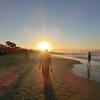Looking for budget stays in Berg? This section is designed to save you time, money, and unnecessary stress. We've got insider tips to help you find affordable hostels and the cheapest places to stay in Berg.
The area of Berg, Iceland, is part of the municipality Norðurþing, located in the northeast of Iceland. The biggest town is Husavik, which is also considered to be one of the best locations for whale watching worldwide. The nature is the biggest attraction. A beautiful lava field is just nearby. The unique nature, the tranquillity, and diverse birdlife are hard to beat if you look for a combination of relaxation and nature. Berg is a suitable base if you want to discover the northeast of the island.
Some of the most famous attractions are nearby and easy to reach. For example, Europe's most powerful waterfall, Dettifoss, is a ninety-minute drive, and Mývatn Nature Baths is less than one hour away. Dimmuborgir is another stunning sight; the area is full of cliffs, lava rocks, and caves. The numerous trails around the lava field are perfect for hikers to enjoy the extraordinary nature and the excellent panorama over the nearby Skjálfandi Bay.
The area is very sparsely populated. Very limited options exist for a hostel in Berg, Iceland, but a stay here will land you right amid the unspoilt nature of northern Iceland. Your Berg, Iceland hostel is open all year round and free parking is included for the many travelers in the region who do the ring road and get around by car. These travelers are more flexible and have more accommodations from which to choose. If you do not like the choices for a hostel in Berg, Iceland, you can check out the nearby town of Húsavik; it is a twenty-minute drive and this town boasts a couple of hostels, hotels, and guesthouses.
You cannot expect a warm summer in Northern Iceland -- the weather is chilly and temperatures usually range from twelve to fifteen degrees Celsius. Snowfall is common in winter, when the maximum temperature is around two degrees Celsius. Dark winters and very long summer days are typical for the north of Europe.
Written by Travel Expert Berg
 Flo
Flo